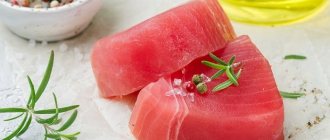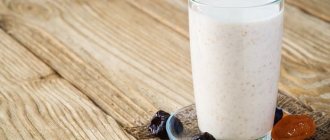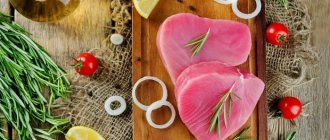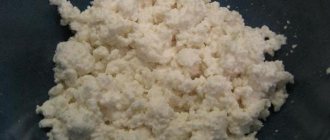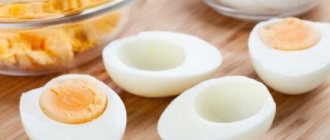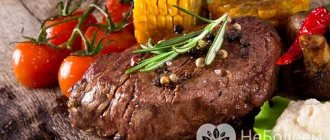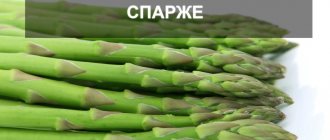01/13/2015 / Fish and seafood
| Lightly salted salmon, BZHU and calorie content per 100 g of product | |||
| Calorie content 195 kcal | Proteins 23 g | Fat 13 g | Carbohydrates 0 g |
Salmon belongs to the salmon family; it is considered an anadromous fish and is a valuable commercial object. The maximum weight of one individual can reach 40 kg, and the length can be more than 1 meter. The fish has small scales and does not have any spots below the lateral line. Habitat: the Atlantic and Arctic Oceans, the Baltic Sea.
In the autumn-summer period, Salmon is able to move to freshwater bodies with the current. Spawning occurs in the autumn, when the fish becomes covered with characteristic red spots on the head and sides. Freshwater Salmon feeds on invertebrates and small fish; marine species prefer to feast on crustaceans.
How to choose fresh, lightly salted and salted fish
The captured carcasses are cooled.
They are sent to processing plants, where they are deep frozen, salted, the pieces are smoked, packed in vacuum bags and sent to retail chains.
Often cut into fillets, steaks 2-3 cm thick.
Chilled salmon meat has a soft orange, slightly reddish color.
When pressed, there are no dents left, the flesh is elastic. A fresh carcass has a subtle fishy smell.
Lightly salted or smoked fish is sold by weight or packaged
.
Before purchasing, you must check the expiration date of the finished product.
Find out some more useful tips for choosing quality salmon from the video:
Chemical composition, how many calories are in 100 grams, BJU content
Salmon is a unique product in composition,
it is rich in polyunsaturated fatty acids, vitamins, minerals, and has low calorie content:
Amount of essential vitamins contained in 100 g:
- A - 0.04 mg;
- B1 – 0.23 mg;
- B2 – 0.25 mg;
- PP – 1.62 mg;
- C – 1.0 mg.
Mass of minerals in 100 g of product:
- Sodium - 45 mg.
- Potassium - 420 mg.
- Calcium - 15 mg.
- Magnesium - 25 mg.
- Phosphorus - 210 mg.
- Iron - 0.80 mg.
In smaller quantities - chlorine, zinc, chromium, nickel, molybdenum.
Beneficial features
Salmon is one of the few types of fish that contains a large number of useful elements. With its regular use, depressive syndromes disappear faster and mood improves. Salmon meat contains substances that significantly strengthen the immune system and help restore the elasticity of blood vessels. They are also involved in the renewal of bone tissue, improve blood circulation, and prevent joint diseases and rheumatism.
The vitamins contained in the meat and caviar of the described fish ensure the active functioning of a person, prevent premature aging, and minimize the risk of blood clots.
Useful properties, effects on the human body
A lot of the positive properties of salmon are associated with the presence of Omega-3 polyunsaturated acids in it. The body does not reproduce such acids on its own; it can accumulate them when receiving food rich in Omega-3.
It is important to regularly eat salmon and other types of fatty fish.
The intake of polyunsaturated acids has a positive effect on the functioning of human systems and organs:
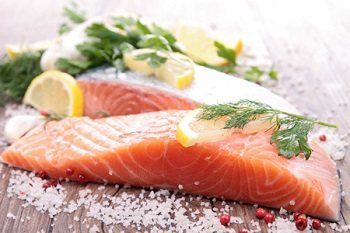
- Prevents the development of heart disease, reduces the likelihood of blood clots, which reduces the risk of strokes, Alzheimer's disease, and heart attacks.
- Makes the walls of blood vessels more elastic.
- Has a beneficial effect on the functioning of the nervous system. Mandatory in the diet of people suffering from depressive disorders, vegetative-vascular dystonia and other diseases of the central nervous system.
- Slows down age-related skin aging, improves the condition of the skin with atopic dermatitis and psoriasis.
- Strengthens the immune system. Eating weekly reduces the occurrence of complications during colds.
The vitamins contained in salmon have the following effects on the human body:
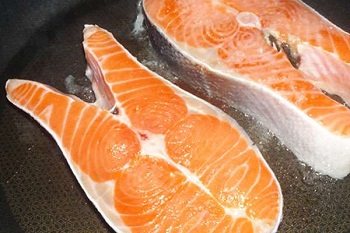
Contains a number of minerals:
- Potassium is an essential element for the functioning of the heart muscle, nervous system, and skeletal system.
- Sodium is an important substance for the normal functioning of the body, maintaining the acid-base balance for the normal functioning of the enzyme system.
- Phosphorus is responsible for the condition of human teeth and bones.
- Calcium is a microelement that is responsible for the functioning of the muscular and skeletal systems.
- Magnesium is responsible for the functioning of the heart, nervous system, and muscles. It is often prescribed for high mental and physical stress. It has a vasodilating effect and is involved in the separation of bile.
The chemical composition of salmon includes vitamins and minerals that promote better absorption of each other. This makes the product useful for many groups of the population.
How many calories are in salmon
Of course, it would be impossible to call this fish the lightest of all, and yet it does not weigh that much compared to other animal sources of protein: the calorie content of salmon is 153 kcal per hundred grams. In terms of energy value, the distribution between proteins and fats is almost equal: 52% is given to the former, 48% to the latter. But if you had to worry about the latter, for example, in pork, remembering the risk of overloading the pancreas, then with salmon there is no need for such precautions. The largest part of the fats found in it are Omega-3 polyunsaturated fatty acids, which are already present almost everywhere. They prevent various kinds of inflammatory processes, participate in the formation of energy reserves, where they are the “core” of everything, and synthesize prostaglandins: substances that are especially important for the female reproductive system, in particular for the uterus. You don’t even need to mention the effect of Omega-3 on cardiovascular activity. In addition, these fatty acids protect against autoimmune diseases and slow down the development of allergies and their attacks, strengthen bone and muscle tissue, and due to the ability to envelop internal organs, they neutralize gastritis, peptic ulcers and various types of inflammatory processes in the gastrointestinal tract. But to preserve their beneficial properties and avoid the risk of converting beneficial fatty acids into harmful carcinogenic fats, steam the salmon. In this case, calorie content will also remain the least dangerous.
It would not be amiss to separately note the fact that it is in sea fish that the proportion of Omega-3 is so high: in river fish this fatty acid is several times less. Specifically in salmon, its content per hundred grams of product is equal to the daily requirement. If there is a deficiency of this element, either fish oil is prescribed or it is recommended to include salmon in your menu. Its caloric content allows you not to worry about your figure, even if you eat this seafood daily and for dinner, and not for lunch.
In addition to polyunsaturated fatty acids, salmon is also rich in vitamin E, which acts as a natural antioxidant that protects against the effects of free radicals, reducing the risk of malignant tumors, including working as a cancer prevention. In addition, it is necessary for athletes and anyone who has systematic significant physical and mental stress, and also participates in the formation of estrogen. In salmon, which has a low calorie content, the proportion of vitamin E is almost the daily requirement: 1.8 mg per hundred grams of product.
As for lightly salted salmon, the calorie content of which increases to 202 kcal per hundred-gram piece, the protein level in it decreases slightly - to 45%, and the proportion of fat increases - to 56%. With all this, the most important beneficial substances in it are preserved even after salting, but the content of melatonin, which helps fight insomnia, increases greatly, as does the amount of vitamin E. Since the calorie content of lightly salted salmon is low, fish processed in this way can also be consumed during during the weight loss process, but you should not get carried away with it due to the fact that salt retains water: while losing extra pounds, this effect is undesirable. In addition to the fact that it slows down the change of numbers on the scales, excess salt overloads the liver, kidneys, and even the movement of blood in the vessels. Therefore, even despite the not-so-scary caloric value for lightly salted salmon, it is not recommended to eat it during the period of getting rid of problem areas.
Is it possible during a diet?

Salmon is prohibited during strict low-calorie diets
to achieve rapid weight loss.
However, it is indispensable with proper nutrition for a long-term weight loss effect.
Does not contain carbohydrates.
The polyunsaturated acids included in the composition promote the production of leptin, which is involved in metabolism.
70 g of fish per week can replenish protein, vitamins and minerals in conditions of limited nutrient intake during the diet.
It is not advisable to eat lightly salted or smoked fish.
Salt retains water in the body, increasing weight.
Application
Salmon is best known to a wide range of consumers in its smoked and lightly salted form. This is usually presented as a cold appetizer or delicacy. This fish is often present in salads and light snacks, and is used as a filling for rolls. Moreover, it can be purchased in ready-salted form or marinated at home with the addition of your favorite spices and seasonings.
But fresh Salmon has a distinct taste, from which it is customary to prepare delicate and appetizing creamy soups. This fish is also suitable for frying, and it can be combined with the most common and affordable products - side dishes, marinades, sauces. To preserve all the nutrients included in the product described, it is recommended to bake it on the grill or in foil in the oven.
Market Analytics
- 2020: an unprecedented test for the global cosmetics industry
- Top 10 Cosmetic Research and Development of 2021
- 2020 in the beauty industry – innovation without borders
Convenient search for beauty salons on our website
Beauty salons in Moscow Beauty salons in St. Petersburg Beauty salons in Ekaterinburg Beauty salons in Novosibirsk
Latest blog posts on our website
- Naturecream / Esterified oils
- Naturecream / Arnica - the magical plant of alchemists
- Naturecream / Tremella Extract - Snow Mushroom Detox for Skin
- Prostye-sovety / How to visually enlarge your lips with makeup
- Naturecream / Apricot kernel oil for face
- Naturecream / MATRIXYL3000 - the best skin elasticity stimulator
- Naturecream / SPF in Natural Oils
- Naturecream / Geranium (Pelargonium) oil for skin health and beauty
- Prostye-sovety / Save on a beauty salon: procedures that can be done at home
- Naturecream / Growth Factor - brings back youth?
Latest forum topics on our website
- Natalya / How to properly make a gelatin mask?
- Mrs._Smith / Badly sunburned! What to do?((
- Ice / Is it necessary to combine fitness classes with a diet?
- Antonova / What can be used for hair loss?
- Radio operatorKat / Who was on a protein diet?
Other articles in this section
| Fried river perch Perch is a fish that lives in almost all bodies of water, except mountain rivers with fast flows and reservoirs with cold water. This type of fish has a dark green coloration at the base of its back. Toward the belly, the color changes to a more yellowish color. A characteristic feature of perch is the presence of transverse dark stripes, the number of which can reach 7 pieces. |
| Flying fish caviar Flying fish is a small ocean inhabitant. The population consists of about 50 species. The flying fish gets its name due to its developed pelvic fins, which give it the ability to jump above the surface of the water. This fish, like its caviar, is very popular in Indian and Japanese cuisines. |
| Bream Bream is a fairly large fish of the carp family, reaching a weight of 10 kg. It has a fairly wide distribution and is often found in reservoirs located in Europe. According to the nature of its habitat, it is characterized by the formation of small flocks. In Russia, since Soviet times, bream has been bred in specially equipped protected artificial ponds, where it is fattened for subsequent sale. The popularity of bream is still quite high. |
| Hot smoked flounder Many nutritionists have already unanimously agreed that fish is much healthier and more valuable as a source of nutrients than meat. Fish meat is easily digestible by the body, it is rich in various unique and beneficial substances, and smoked fish can become a simple and very healthy delicacy for the whole family. |
| Salted pike perch Pike perch is a well-known representative of perch. Lives in fresh water bodies and rivers. For its habitat, pike perch prefers exclusively clean water bodies. Therefore, fish does not contain phosphates and harmful impurities. The fish has an elongated body, a gray-green back, and brown stripes on the sides. Pike perch have large, spiny fins. There are many dark spots on the caudal fin. The eyes of pike perch have a yellow tint. The size of an adult individual can reach a meter in length and a weight of 20 kg. Pike perch has white meat with virtually no fatty layers. |
| Ruff The ruff fish is one of the representatives of the perch family. This is a freshwater fish, the main habitat of which is European water bodies (rivers, lakes, dams), preferably with a sandy bottom. It is very voracious, feeding on small fish, invertebrates and some plants. The length of an adult individual sometimes reaches more than 20 cm. But usually this type of fish is 10-12 cm in length, the ruff has a mass of about 15-25 grams. |
| Smoked mackerel Mackerel is a very common fish that lives in the temperate waters of almost all oceans. At the same time, this fish can be called quite unpretentious. Very often it is found in those waters where the temperature regime is quite varied. The fish belongs to the mackerel family. This species is extremely popular in industry: the fish is caught in huge quantities, and the demand for it is not becoming less. |
| Coho Salmon Pacific waters are rich in species of flora and fauna. The huge quantity of fish attracts many fishing companies. One of the popular types of Pacific fish is coho salmon. Belonging to the salmon family, the fish can have a wide variety of sizes. Basically, this factor depends on the habitat. The largest individuals are observed in Asian waters - their length can reach one meter and weight up to 15 kg. In the waters of North America you can find quite a lot of coho salmon, but of a much smaller size. |
| Fugu There is an exotic dish in Japanese cuisine called “fugu fish,” which is expensive and deadly. This small fish is also called dogfish, pufferfish, fahak and diodont. Its place of residence is the Indian and Pacific oceans. It differs from other fish in that it has no scales and swims tail first. At the first danger, it inflates and turns into a ball. This sea animal is also famous for containing the poison tetrodoxin. Historians have found evidence that this fish was consumed even before our era - the ancient Japanese clearly knew even then the secret of preparing a dish from this fish. |
| Scallop Scallop is a luxurious seafood delicacy that is little known to connoisseurs of healthy and wholesome food. It is a bivalve mollusk - a member of the Pectinacea family. Found in almost all seas. There are about 15 species in the Black Sea. Some of them serve as cultivated and commercial objects. This product is well known among consumers. |
Use in cosmetology
Cosmetology companies actively use salmon caviar in the production of creams. It has a more concentrated amount of beneficial microelements and vitamins than meat.
Cosmetic products for nutrition and skin rejuvenation are made based on caviar extract.
, enhancing collagen production, developing anti-aging skin care lines.
In home cosmetology, neither salmon nor products made from it are widely used due to their high cost.
What is useful in medicine
Salmon is used to produce medicines to combat diabetes, pancreatic diseases, and hematopoiesis.
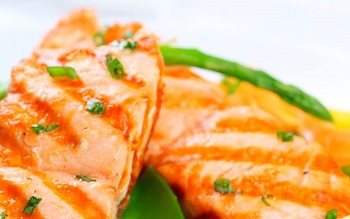
Widely used in prescribing therapeutic diets:
- in the rehabilitation period after exacerbations of cardiovascular diseases;
- for chronic respiratory diseases;
- cerebrovascular accidents;
- diseases of the bone and nervous systems.
If you have chronic diseases, you need to arrange 2-3 “fish days” per week
.
Use in cooking
Fish meat is tender and does not require lengthy cooking.
Boiled
How to cook:
- Wash the salmon pieces thoroughly under cool running water.
- Place the fish steak in a container of water, put it on the fire, and bring to a boil.
- Boil for 15 minutes.
- Add salt to taste.
Baked in the oven
Baking is an easy way to obtain tender fish with the most preserved vitamins and minerals.
For baking:
- Fish steaks 2-3 cm thick must be washed.
- Lightly pepper and salt on both sides.
- Place fish pieces on foil sprinkled with vegetable oil.
- Lightly sprinkle lemon juice on top, half a teaspoon of juice for each steak.
- Carefully wrap the foil to cover the top of the steaks.
- Place in a preheated oven.
- Bake for 15 minutes at 180 degrees.
Delicious snack
To create snack dishes, lightly salted or smoked fish is often used:
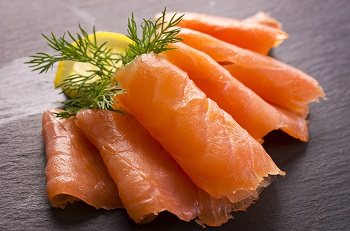
- Spread soft melted cheese thinly on a thin unleavened sheet of lavash.
- Arrange thinly sliced pieces of lightly salted salmon.
- Roll tightly to form a roll.
- Wrap with cling film.
- Place in the refrigerator for several hours.
- Remove and cut into portions.
- You can decorate by thinly slicing a fresh cucumber and twisting it into a rose shape on each piece of roll.
Fresh fish is available to residents of the fishing grounds.
More often it goes on sale frozen.
After purchasing frozen fish, the carcass or steaks are left in the refrigerator until completely thawed. This way, beneficial cellular juices will remain in the meat.
Whole fish are thoroughly washed, scaled, the head is cut off, gutted, cut into portions or salted whole or subjected to further culinary processing.
Boiling, steaming, grilling, baking allow you to quickly cook tender meat
, maintaining all the benefits without increasing the calorie content of the dish. It is recommended to eat salmon with vegetables for lunch or dinner, no later than 3-4 hours before bedtime.
It is advisable for a healthy person to include fish products in their diet 2 times a week, one of which is a fatty variety. The recommended 70-100 grams of salmon will cover half of the body’s daily requirement in proteins.
It is forbidden to consume more than 250 g per day due to the large amount of protein.
How else to cook salmon tasty and healthy, watch in this video:
Contraindications
It should be included with caution in the diet of people with allergies to fish and seafood. Obese patients, cholelithiasis, and people with kidney diseases should not overuse salted and smoked salmon.
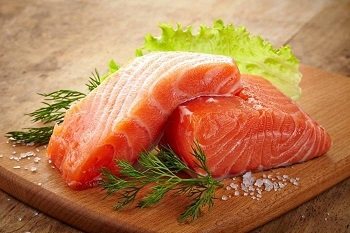
Fish grown in natural conditions has beneficial properties.
But in nature it is becoming less and less common.
Demand for salmon exceeds supply. Many suppliers grow it in equipped water areas. They are fed special food with additives to quickly gain muscle mass.
Artificially grown has a light shade of meat. Therefore, when feeding, dyes are added to add brightness to the pulp.
The amount of useful substances in such fish is much less than in wild fish.
Meat may contain residual amounts of additives that enter the body, putting stress on the liver.
Salmon is a healthy product that contains a number of vitamins, micro- and macroelements. It should be used by all groups of the population, except children under three years of age and obese patients, with kidney disease, gall bladder, and allergies. Possible harm can be caused by fish grown artificially.
CHEMICAL COMPOSITION AND NUTRITIONAL ANALYSIS
Nutritional value and chemical composition of “Salted salmon”.
The table shows the nutritional content (calories, proteins, fats, carbohydrates, vitamins and minerals) per 100 grams of edible portion.
| Nutrient | Quantity | Norm** | % of the norm in 100 g | % of the norm in 100 kcal | 100% normal |
| Calorie content | 202 kcal | 1684 kcal | 12% | 5.9% | 834 g |
| Squirrels | 22.5 g | 76 g | 29.6% | 14.7% | 338 g |
| Fats | 12.5 g | 56 g | 22.3% | 11% | 448 g |
| Water | 56.5 g | 2273 g | 2.5% | 1.2% | 4023 g |
| Ash | 8.5 g | ~ | |||
| Vitamins | |||||
| Vitamin A, RE | 30 mcg | 900 mcg | 3.3% | 1.6% | 3000 g |
| Retinol | 0.03 mg | ~ | |||
| Vitamin B1, thiamine | 0.15 mg | 1.5 mg | 10% | 5% | 1000 g |
| Vitamin B2, riboflavin | 0.2 mg | 1.8 mg | 11.1% | 5.5% | 900 g |
| Vitamin B4, choline | 0.731 mg | 500 mg | 0.1% | 68399 g | |
| Vitamin B5, pantothenic | 1.6 mg | 5 mg | 32% | 15.8% | 313 g |
| Vitamin B6, pyridoxine | 0.8 mg | 2 mg | 40% | 19.8% | 250 g |
| Vitamin B9, folates | 25 mcg | 400 mcg | 6.3% | 3.1% | 1600 g |
| Vitamin B12, cobalamin | 3 mcg | 3 mcg | 100% | 49.5% | 100 g |
| Vitamin C, ascorbic acid | 1 mg | 90 mg | 1.1% | 0.5% | 9000 g |
| Vitamin D, calciferol | 10.2 mcg | 10 mcg | 102% | 50.5% | 98 g |
| Vitamin E, alpha tocopherol, TE | 2.5 mg | 15 mg | 16.7% | 8.3% | 600 g |
| Vitamin K, phylloquinone | 0.5 mcg | 120 mcg | 0.4% | 0.2% | 24000 g |
| Vitamin RR, NE | 10 mg | 20 mg | 50% | 24.8% | 200 g |
| Niacin | 6.2 mg | ~ | |||
| Macronutrients | |||||
| Potassium, K | 221 mg | 2500 mg | 8.8% | 4.4% | 1131 g |
| Calcium, Ca | 40 mg | 1000 mg | 4% | 2% | 2500 g |
| Magnesium, Mg | 60 mg | 400 mg | 15% | 7.4% | 667 g |
| Sodium, Na | 2970 mg | 1300 mg | 228.5% | 113.1% | 44 g |
| Sera, S | 225 mg | 1000 mg | 22.5% | 11.1% | 444 g |
| Phosphorus, Ph | 243 mg | 800 mg | 30.4% | 15% | 329 g |
| Chlorine, Cl | 4477 mg | 2300 mg | 194.7% | 96.4% | 51 g |
| Microelements | |||||
| Iron, Fe | 2.5 mg | 18 mg | 13.9% | 6.9% | 720 g |
| Yod, I | 50 mcg | 150 mcg | 33.3% | 16.5% | 300 g |
| Cobalt, Co | 20 mcg | 10 mcg | 200% | 99% | 50 g |
| Manganese, Mn | 0.05 mg | 2 mg | 2.5% | 1.2% | 4000 g |
| Copper, Cu | 250 mcg | 1000 mcg | 25% | 12.4% | 400 g |
| Molybdenum, Mo | 4 mcg | 70 mcg | 5.7% | 2.8% | 1750 g |
| Nickel, Ni | 6 mcg | ~ | |||
| Selenium, Se | 36.5 mcg | 55 mcg | 66.4% | 32.9% | 151 g |
| Fluorine, F | 430 mcg | 4000 mcg | 10.8% | 5.3% | 930 g |
| Chromium, Cr | 55 mcg | 50 mcg | 110% | 54.5% | 91 g |
| Zinc, Zn | 0.7 mg | 12 mg | 5.8% | 2.9% | 1714 g |
| Sterols (sterols) | |||||
| Cholesterol | 108 mg | max 300 mg | |||
| Saturated fatty acids | |||||
| Saturated fatty acids | 2.3 g | max 18.7 g | |||
| Monounsaturated fatty acids | 4.15 g | min 16.8 g | 24.7% | 12.2% | |
| Polyunsaturated fatty acids | 5.11 g | from 11.2 to 20.6 g | 45.6% | 22.6% | |
| Omega-3 fatty acids | 4.14 g | from 0.9 to 3.7 g | 111.9% | 55.4% | |
| Omega-6 fatty acids | 0.864 g | from 4.7 to 16.8 g | 18.4% | 9.1% |
The energy value of salted salmon is 202 kcal.
Main source: Skurikhin I.M. and others. Chemical composition of food products. .
** This table shows the average levels of vitamins and minerals for an adult. If you want to know the norms taking into account your gender, age and other factors, then use the My Healthy Diet app.
Calorie content Lightly salted salmon. Chemical composition and nutritional value.
Nutritional value and chemical composition of “Lightly salted salmon”.
The table shows the nutritional content (calories, proteins, fats, carbohydrates, vitamins and minerals) per 100 grams of edible portion.
| Nutrient | Quantity | Norm** | % of the norm in 100 g | % of the norm in 100 kcal | 100% normal |
| Calorie content | 150 kcal | 1684 kcal | 8.9% | 5.9% | 1123 g |
| Squirrels | 19 g | 76 g | 25% | 16.7% | 400 g |
| Fats | 8 g | 56 g | 14.3% | 9.5% | 700 g |
| Water | 56.5 g | 2273 g | 2.5% | 1.7% | 4023 g |
| Ash | 8.5 g | ~ | |||
| Vitamins | |||||
| Vitamin A, RE | 30 mcg | 900 mcg | 3.3% | 2.2% | 3000 g |
| Retinol | 0.03 mg | ~ | |||
| Vitamin B1, thiamine | 0.15 mg | 1.5 mg | 10% | 6.7% | 1000 g |
| Vitamin B2, riboflavin | 0.2 mg | 1.8 mg | 11.1% | 7.4% | 900 g |
| Vitamin B4, choline | 0.731 mg | 500 mg | 0.1% | 0.1% | 68399 g |
| Vitamin B5, pantothenic | 1.6 mg | 5 mg | 32% | 21.3% | 313 g |
| Vitamin B6, pyridoxine | 0.8 mg | 2 mg | 40% | 26.7% | 250 g |
| Vitamin B9, folates | 25 mcg | 400 mcg | 6.3% | 4.2% | 1600 g |
| Vitamin B12, cobalamin | 3 mcg | 3 mcg | 100% | 66.7% | 100 g |
| Vitamin C, ascorbic acid | 1 mg | 90 mg | 1.1% | 0.7% | 9000 g |
| Vitamin D, calciferol | 10.2 mcg | 10 mcg | 102% | 68% | 98 g |
| Vitamin E, alpha tocopherol, TE | 2.5 mg | 15 mg | 16.7% | 11.1% | 600 g |
| Vitamin K, phylloquinone | 0.5 mcg | 120 mcg | 0.4% | 0.3% | 24000 g |
| Vitamin RR, NE | 10 mg | 20 mg | 50% | 33.3% | 200 g |
| Niacin | 6.2 mg | ~ | |||
| Macronutrients | |||||
| Potassium, K | 221 mg | 2500 mg | 8.8% | 5.9% | 1131 g |
| Calcium, Ca | 40 mg | 1000 mg | 4% | 2.7% | 2500 g |
| Magnesium, Mg | 60 mg | 400 mg | 15% | 10% | 667 g |
| Sodium, Na | 2970 mg | 1300 mg | 228.5% | 152.3% | 44 g |
| Sera, S | 225 mg | 1000 mg | 22.5% | 15% | 444 g |
| Phosphorus, P | 243 mg | 800 mg | 30.4% | 20.3% | 329 g |
| Chlorine, Cl | 4477 mg | 2300 mg | 194.7% | 129.8% | 51 g |
| Microelements | |||||
| Iron, Fe | 2.5 mg | 18 mg | 13.9% | 9.3% | 720 g |
| Yod, I | 50 mcg | 150 mcg | 33.3% | 22.2% | 300 g |
| Cobalt, Co | 20 mcg | 10 mcg | 200% | 133.3% | 50 g |
| Manganese, Mn | 0.05 mg | 2 mg | 2.5% | 1.7% | 4000 g |
| Copper, Cu | 250 mcg | 1000 mcg | 25% | 16.7% | 400 g |
| Molybdenum, Mo | 4 mcg | 70 mcg | 5.7% | 3.8% | 1750 g |
| Nickel, Ni | 6 mcg | ~ | |||
| Selenium, Se | 36.5 mcg | 55 mcg | 66.4% | 44.3% | 151 g |
| Fluorine, F | 430 mcg | 4000 mcg | 10.8% | 7.2% | 930 g |
| Chromium, Cr | 55 mcg | 50 mcg | 110% | 73.3% | 91 g |
| Zinc, Zn | 0.7 mg | 12 mg | 5.8% | 3.9% | 1714 g |
| Sterols (sterols) | |||||
| Cholesterol | 108 mg | max 300 mg | |||
| Saturated fatty acids | |||||
| Saturated fatty acids | 2.3 g | max 18.7 g | |||
| Monounsaturated fatty acids | 4.15 g | min 16.8 g | 24.7% | 16.5% | |
| Polyunsaturated fatty acids | 5.11 g | from 11.2 to 20.6 g | 45.6% | 30.4% | |
| Omega-3 fatty acids | 4.14 g | from 0.9 to 3.7 g | 111.9% | 74.6% | |
| Omega-6 fatty acids | 0.864 g | from 4.7 to 16.8 g | 18.4% | 12.3% |
The energy value of lightly salted salmon is 150 kcal.
Primary Source: Created in the application by the user. Read more.
** This table shows the average levels of vitamins and minerals for an adult. If you want to know the norms taking into account your gender, age and other factors, then use the “My Healthy Diet” application.
Product calorie analysis
SHARE OF BZHU IN CALORIES
Ratio of proteins, fats and carbohydrates:
Knowing the contribution of proteins, fats and carbohydrates to calorie content, you can understand how well a product or diet meets the standards of a healthy diet or the requirements of a certain diet. For example, the US and Russian Departments of Health recommend 10-12% of calories come from protein, 30% from fat and 58-60% from carbohydrates. The Atkins diet recommends low carbohydrate intake, although other diets focus on low fat intake.
If more energy is expended than it is received, the body begins to use up fat reserves, and body weight decreases.
Try filling out your food diary right now without registration.
Find out your additional calorie expenditure for training and get updated recommendations absolutely free.
DATE FOR ACHIEVEMENT OF THE GOAL
Salted salmon
rich in vitamins and minerals such as: vitamin B2 - 11.1%, vitamin B5 - 32%, vitamin B6 - 40%, vitamin B12 - 100%, vitamin D - 102%, vitamin E - 16.7%, vitamin PP - 50%, magnesium - 15%, phosphorus - 30.4%, chlorine - 194.7%, iron - 13.9%, iodine - 33.3%, cobalt - 200%, copper - 25%, selenium - 66 .4%, chromium - 110%
- Vitamin B2
is involved in redox reactions, helps to increase the color sensitivity of the visual analyzer and dark adaptation. Insufficient intake of vitamin B2 is accompanied by impaired condition of the skin, mucous membranes, and impaired light and twilight vision. - Vitamin B5
is involved in protein, fat, carbohydrate metabolism, cholesterol metabolism, the synthesis of a number of hormones, hemoglobin, promotes the absorption of amino acids and sugars in the intestines, and supports the function of the adrenal cortex. A lack of pantothenic acid can lead to damage to the skin and mucous membranes. - Vitamin B6
is involved in maintaining the immune response, processes of inhibition and excitation in the central nervous system, in the transformation of amino acids, the metabolism of tryptophan, lipids and nucleic acids, promotes the normal formation of red blood cells, and maintaining normal levels of homocysteine in the blood. Insufficient intake of vitamin B6 is accompanied by decreased appetite, impaired skin condition, and the development of homocysteinemia and anemia. - Vitamin B12
plays an important role in the metabolism and transformation of amino acids. Folate and vitamin B12 are interconnected vitamins that are involved in hematopoiesis. A lack of vitamin B12 leads to the development of partial or secondary folate deficiency, as well as anemia, leukopenia, and thrombocytopenia. - Vitamin D
maintains calcium and phosphorus homeostasis and carries out the processes of bone tissue mineralization. A lack of vitamin D leads to impaired metabolism of calcium and phosphorus in the bones, increased demineralization of bone tissue, which leads to an increased risk of developing osteoporosis. - Vitamin E
has antioxidant properties, is necessary for the functioning of the gonads and heart muscle, and is a universal stabilizer of cell membranes. With vitamin E deficiency, hemolysis of erythrocytes and neurological disorders are observed. - Vitamin PP
is involved in redox reactions of energy metabolism. Insufficient vitamin intake is accompanied by disruption of the normal condition of the skin, gastrointestinal tract and nervous system. - Magnesium
is involved in energy metabolism, the synthesis of proteins, nucleic acids, has a stabilizing effect on membranes, and is necessary to maintain the homeostasis of calcium, potassium and sodium. A lack of magnesium leads to hypomagnesemia, an increased risk of developing hypertension and heart disease. - Phosphorus
takes part in many physiological processes, including energy metabolism, regulates acid-base balance, is part of phospholipids, nucleotides and nucleic acids, and is necessary for the mineralization of bones and teeth. Deficiency leads to anorexia, anemia, and rickets. - Chlorine
is necessary for the formation and secretion of hydrochloric acid in the body. - Iron
is part of proteins with various functions, including enzymes. Participates in the transport of electrons and oxygen, ensures the occurrence of redox reactions and activation of peroxidation. Insufficient consumption leads to hypochromic anemia, myoglobin deficiency atony of skeletal muscles, increased fatigue, myocardiopathy, and atrophic gastritis. - Iodine
is involved in the functioning of the thyroid gland, ensuring the formation of hormones (thyroxine and triiodothyronine). Necessary for the growth and differentiation of cells of all tissues of the human body, mitochondrial respiration, regulation of transmembrane transport of sodium and hormones. Insufficient intake leads to endemic goiter with hypothyroidism and slowing of metabolism, arterial hypotension, stunted growth and mental development in children. - Cobalt
is part of vitamin B12. Activates enzymes of fatty acid metabolism and folic acid metabolism. - Copper
is part of enzymes that have redox activity and are involved in the metabolism of iron, stimulates the absorption of proteins and carbohydrates. Participates in the processes of providing oxygen to the tissues of the human body. Deficiency is manifested by disturbances in the formation of the cardiovascular system and skeleton, and the development of connective tissue dysplasia. - Selenium
is an essential element of the antioxidant defense system of the human body, has an immunomodulatory effect, and is involved in the regulation of the action of thyroid hormones. Deficiency leads to Kashin-Beck disease (osteoarthritis with multiple deformities of the joints, spine and limbs), Keshan disease (endemic myocardiopathy), and hereditary thrombasthenia. - Chromium
is involved in the regulation of blood glucose levels, enhancing the effect of insulin. Deficiency leads to decreased glucose tolerance.
more hide
You can see the complete directory of the most useful products in the appendix - a set of properties of a food product, the presence of which satisfies a person’s physiological needs for the necessary substances and energy.
Vitamins
, organic substances required in small quantities in the diet of both humans and most vertebrates. Vitamin synthesis is usually carried out by plants, not animals. A person's daily requirement for vitamins is only a few milligrams or micrograms. Unlike inorganic substances, vitamins are destroyed by strong heat. Many vitamins are unstable and are “lost” during cooking or food processing.
Everyone knows that any fish is healthy. Many nutritionists and conventional doctors advise eating more fish and less meat. But, even if you are not a seafood lover, small amounts of these products should be consumed.
Of course, one of the most popular sea creatures is salmon. The calorie content of salmon is very high, and despite this, it is excellent for dietary nutrition.
Salmon contains a lot of useful substances. These are vitamins of group B, as well as A, C, D, E and PP. It also contains many trace elements such as sodium, phosphorus, potassium, fluorine, iodine, sulfur, chlorine and others.
Yes, this marine inhabitant is not low-calorie. However, due to the fact that it contains fats and proteins, but absolutely no carbohydrates, the dish you eat will not put extra centimeters on your waist.
Moreover, this product contains the Omega-3 amino acid and several other fatty acids, which promote the breakdown of fat and have an extremely beneficial effect on metabolism. The calorie content of salmon is quite high and yet it is perfect for people who want to lose weight.
In terms of its properties, this sea creature is simply a Goldfish. It is recommended for use by both children and adults. It will be useful for men and women, people engaged in mental work and workers with heavy physical activity.
Calorie content of steamed salmon
It may seem to many that salmon, which is a fatty fish, should not be included in the diet of people who are watching their weight. But this is not so, or rather, quite the opposite. The fact is that the amino acids contained in salmon enhance metabolic reactions in the body, which promotes weight loss, in turn, protein and a set of minerals and vitamins saturate the body without the risk of gaining kilograms.
You just need to understand that the beneficial properties of salmon will not be fully preserved during heat treatment, so it is recommended to steam the salmon or eat it lightly salted.
The calorie content of steamed salmon is 153 kcal per hundred grams of product. In turn, boiled salmon contains 176 kcal per hundred grams of product. It is best, of course, to cook salmon soup. In this case, the calorie content of salmon will be no more than 67 kcal per hundred grams of product.
Based on this caloric value of steamed salmon, we can conclude that in this form the fish is quite suitable for dietary nutrition.
Salmon danger
Of course, like any product, this fish has its contraindications. Not all people are recommended to eat it.
You should beware of red fish if:
- You have allergic reactions to salmon or seafood in general;
- You suffer from urolithiasis and kidney disease;
- you have liver problems;
- Have stones in the kidneys or gall bladder;
- You have inflammation in the gastrointestinal tract;
- You suffer from high blood pressure;
Briefly about the dishes
It is a well-known fact that heat treatment of any products deprives them of a certain part of their beneficial substances. The story is similar with this marine inhabitant. In addition, the calorie content of salmon depends on the method of its preparation.
Of course, each person has their own food preferences, but it’s still worth thinking about what exactly you eat and how beneficial it is for you and your figure.
Lightly salted and salted
The most popular dish is lightly salted salmon. In this form, it is most often found on store shelves. It is worth noting that such a product will be healthier than salted salmon.
After all, salted fish contains more salt, which in itself is not very healthy. After all, salt greatly retains water in the body, which can cause swelling. Also, salted salmon contains fewer beneficial properties.
Steamed dishes
Steamed salmon is the healthiest of all the dishes that can be prepared from this type of fish. But this is not news. It is a well-known fact that almost any steamed product will be healthier than, for example, fried. For people watching their weight, steamed food is a salvation and a great help in the process of losing weight.
And don’t worry that steamed food is not very tasty or bland. Today, there are many recipes for steamed dishes that even gourmets will like.
Boiled
Boiled salmon is quite beneficial for the human body in itself. Do not forget that liquid food has an extremely beneficial effect on metabolism. Of course, fish soup is not only a very tasty dish, but also extremely healthy.
In addition, boiled salmon has the lowest calorie content.
Fried foods
Fried fish contains the least amount of vitamins and microelements. If you are a big fan of fried foods, you should fry fish in butter or olive oil.
But still try to avoid eating any fried foods.
Harm to salmon
Harm to this fish can occur if processing technology is violated or improperly stored. For cooking, you need to choose only fresh fish. The meat should be firm and coral pink. The softness of the fish indicates that it has been thawed and then frozen again.
Despite its rather low calorie content, lightly salted salmon should not be consumed if you have high blood pressure, excess weight, or kidney disease. Due to the high salt content, excessive consumption of lightly salted salmon can lead to the development of kidney failure and edema. Raw fish may be contaminated with parasite eggs.
Calorie content of dishes
As mentioned above, the calorie content of salmon depends on the method of its preparation. It can be both extremely useful and quite harmful. But that's not all. After all, the amount of nutrients entering your body depends on what dish you eat. And the more benefits food brings you, the better.
- 100 grams of raw product - 204 Kcal;
- 100 grams of lightly salted salmon - 195 Kcal;
- Salted fish 100 grams - 205 Kcal;
- 100 grams of boiled product - 189 Kcal;
- 100 grams of fried food - 194.4 Kcal;
- 100 grams of steamed food - 197 Kcal.
It is impossible to say exactly how many calories there will be in a particular dish. After all, this parameter depends not only on the method of preparing the dish, but also on where its main ingredient was caught.
Fish caught in the sea has less calories than fish raised in special nurseries. This happens because the specially raised fish eats a certain food and moves very little. In nurseries it grows larger and therefore fatter.
Of course, salmon is an extremely healthy dish in our diet; it carries enormous benefits. It has an extremely beneficial effect on the human body, and the importance of rare amino acids simply cannot be overestimated. Omega-3 is an extremely useful amino acid that has a beneficial effect on many processes in the body. But nevertheless, we should not forget that everything is good in moderation. And you still shouldn’t overeat this product. Otherwise, you can not only get health problems, but also gain extra centimeters in the waist and gain unnecessary kilograms.
Salmon is a delicious product. The taste qualities of this fish are appreciated by many gourmets. It is good fried, pickled, salted and smoked. This red fish is not only endowed with excellent taste, but it is also healthy.
Calorie content of fried salmon
Considering how many calories there are in salmon, it is the leader in the content of useful components and fat content. The calorie content of fried salmon is 196 kcal per hundred grams of product. To reduce this amount of calories at least a little, you need to fry the salmon in refined ghee or vegetable oil, otherwise, under the influence of high temperature, carcinogens can form in the fish.
If you consume only 150 grams of fried salmon per day, this will not affect the change in body weight in any way. If you eat more, and even together with flour products, your body weight may increase.
Calorie content of salmon and its benefits
In terms of calories, salmon is a low-calorie product. Its calorie content in raw form is about 219 kcal per 100 g of product. Moreover, it contains 20.8 g of protein, 15.1 g of fat and does not contain carbohydrates. Salmon often comes to our table in smoked or lightly salted form. The calorie content of lightly salted salmon is about 200 kcal per 100 g of product. The calorie content of smoked salmon is 169 kcal per 100 g of product.
The number of calories in salmon will decrease if this fish is steamed. The calorie content of steamed salmon will be about 153 kcal per 100 g of product. And if you prepare fish soup, the number of calories will decrease to 67 kcal per 100 g of product.
When frying, the calorie content of salmon increases significantly.
Considering how many calories there are in salmon, this red fish is the leader in fat content and content of useful components. It contains a lot of vitamins, fatty acids, unsaturated fats, and minerals. Salmon contains much more vitamins than other salmon fish.
When eating salmon, your mood improves and emotional stress disappears. Including salmon in the diet helps increase the elasticity of brain vessels and improve blood circulation. Salmon is a source of complete, easily digestible protein. Amino acids enter the human body from fish literally an hour after the start of digestion. Therefore, this product is necessary for restoring muscle tissue, skin, and also for strengthening hair follicles. It is especially useful to consume salmon for athletes and athletes, as well as during the recovery period after surgery. Considering that fish is usually consumed in small quantities, the calorie content of salmon does not affect the figure in any way.
Nutritionists and doctors recommend eating salmon to prevent senile dementia and diseases of the nervous system.
Useful properties of salmon
Salmon is considered a royal fish for its excellent taste and quality. What are the benefits of salmon? This question worries many people who monitor their figure and health.
It is known that the calorie content of salmon is high compared to other types of fish; moreover, it contains half the daily requirement of protein per hundred grams and is easily absorbed by the human body. Salmon contains potassium, iodine, phosphorus, zinc, magnesium, fluorine and sodium.
When eating salmon, a person receives twice as many calories as if he ate the same amount of white fish. According to scientists, the fatty acids contained in salmon prevent cardiovascular diseases, reduce blood clots in foods, and improve blood flow in capillaries.
Salmon is especially useful for women who are preparing to become mothers. There is also evidence that eating salmon reduces the symptoms of psoriasis and improves vision and brain function.
In addition to the high calorie content of salmon, it contains a whole complex of vitamins A, B1, B2, B12, PP, C, E, D, and it also contains a whole set of macro- and microelements - phosphorus, potassium, fluorine, sodium, nickel , molybdenum.
Constant consumption of salmon can improve immunity, stimulate blood circulation, the functioning of the nervous and vascular systems, and the gastrointestinal tract. Lightly salted salmon contains substances that prevent the development of thrombophlebitis.
Many scientists claim that salmon can even prevent the development of asthma. This is due to the content of Omega-3 acids, which have an anti-inflammatory effect and are saturated with magnesium. And as you know, with low magnesium levels, people are more susceptible to asthmatic attacks than others.
With constant consumption of salmon meat, your mood improves, emotional stress is relieved, symptoms of depression are eliminated, and your health is maintained.
Considering all of the above, we can confidently conclude that by eating salmon, you can eat healthy, tasty, and even watch your figure. And don’t let the high calorie content of salmon scare you, since fats are different from fats. Some fats simply settle in the body, while others supply the body with the necessary cholesterol, which rejuvenates the body and nourishes cell membranes. Salmon contains only healthy fats, so even those who are on a diet can consume it without fear.
Salmon is a fish that contains up to forty-seven percent fat, so it cannot be called low-calorie. In addition, this fish contains a lot of protein - one hundred grams contains almost twenty grams, which equates to eighty calories. From here you can easily determine the calorie content of salmon - 153 kcal per hundred grams of product.
According to some reports, this caloric value of salmon can be increased to 220 kilocalories.
It is impossible to answer exactly how many calories are in salmon, because it all depends on the saturation of the fish with fats, the amount of which may vary depending on its habitat. Thus, the calorie content of salmon caught at sea, in its natural habitat, will be less than the calorie content of salmon that grew up on a fish farm, where it had little room to move and there was more food. Mostly in stores we buy specially grown fish, so when calculating the calorie content of dishes prepared from salmon, you need to focus on a large number.
Also, many people are concerned about the question of how many calories are in lightly salted and smoked salmon, since this is basically how it ends up on our tables.
The calorie content of lightly salted salmon is 200 kcal per hundred grams of product, and the calorie content of smoked salmon is 169 kcal per hundred grams of product. As you can see, the calorie content of lightly salted salmon is higher than the calorie content of smoked salmon, but fried salmon contains the most calories.

